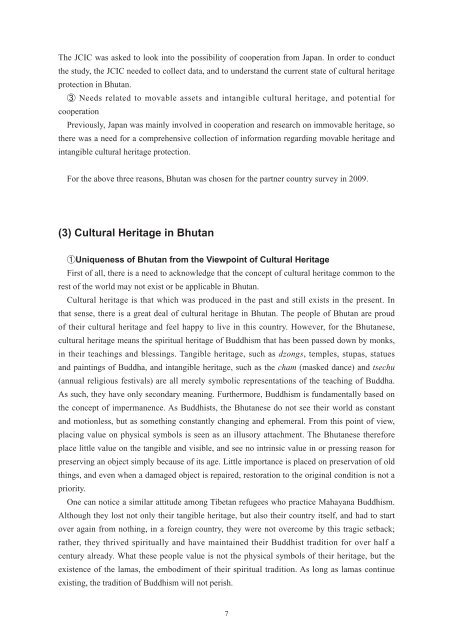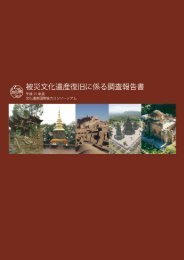English - JCIC-Heritage
English - JCIC-Heritage
English - JCIC-Heritage
You also want an ePaper? Increase the reach of your titles
YUMPU automatically turns print PDFs into web optimized ePapers that Google loves.
The <strong>JCIC</strong> was asked to look into the possibility of cooperation from Japan. In order to conduct<br />
the study, the <strong>JCIC</strong> needed to collect data, and to understand the current state of cultural heritage<br />
protection in Bhutan.<br />
3 Needs related to movable assets and intangible cultural heritage, and potential for<br />
cooperation<br />
Previously, Japan was mainly involved in cooperation and research on immovable heritage, so<br />
there was a need for a comprehensive collection of information regarding movable heritage and<br />
intangible cultural heritage protection.<br />
For the above three reasons, Bhutan was chosen for the partner country survey in 2009.<br />
(3) Cultural <strong>Heritage</strong> in Bhutan<br />
1Uniqueness of Bhutan from the Viewpoint of Cultural <strong>Heritage</strong><br />
First of all, there is a need to acknowledge that the concept of cultural heritage common to the<br />
rest of the world may not exist or be applicable in Bhutan.<br />
Cultural heritage is that which was produced in the past and still exists in the present. In<br />
that sense, there is a great deal of cultural heritage in Bhutan. The people of Bhutan are proud<br />
of their cultural heritage and feel happy to live in this country. However, for the Bhutanese,<br />
cultural heritage means the spiritual heritage of Buddhism that has been passed down by monks,<br />
in their teachings and blessings. Tangible heritage, such as dzongs, temples, stupas, statues<br />
and paintings of Buddha, and intangible heritage, such as the cham (masked dance) and tsechu<br />
(annual religious festivals) are all merely symbolic representations of the teaching of Buddha.<br />
As such, they have only secondary meaning. Furthermore, Buddhism is fundamentally based on<br />
the concept of impermanence. As Buddhists, the Bhutanese do not see their world as constant<br />
and motionless, but as something constantly changing and ephemeral. From this point of view,<br />
placing value on physical symbols is seen as an illusory attachment. The Bhutanese therefore<br />
place little value on the tangible and visible, and see no intrinsic value in or pressing reason for<br />
preserving an object simply because of its age. Little importance is placed on preservation of old<br />
things, and even when a damaged object is repaired, restoration to the original condition is not a<br />
priority.<br />
One can notice a similar attitude among Tibetan refugees who practice Mahayana Buddhism.<br />
Although they lost not only their tangible heritage, but also their country itself, and had to start<br />
over again from nothing, in a foreign country, they were not overcome by this tragic setback;<br />
rather, they thrived spiritually and have maintained their Buddhist tradition for over half a<br />
century already. What these people value is not the physical symbols of their heritage, but the<br />
existence of the lamas, the embodiment of their spiritual tradition. As long as lamas continue<br />
existing, the tradition of Buddhism will not perish.<br />
7




